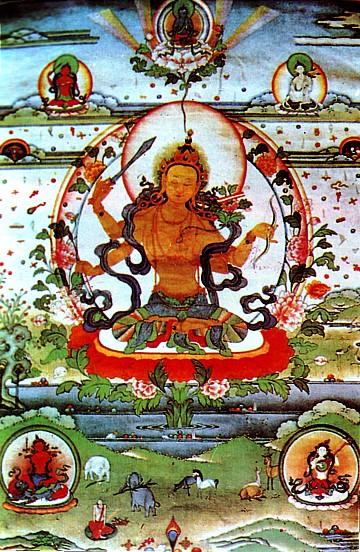Chanting the Names of Manjushri: Difference between revisions
Jump to navigation
Jump to search
No edit summary |
|||
| Line 1: | Line 1: | ||
[[Image:ManjushriScan.jpg|frame|[[Manjushri]]]] | [[Image:ManjushriScan.jpg|frame|[[Manjushri]]]] | ||
'''Chanting the Names of Manjushri''' (Skt. ''Mañjuśrīnāmasaṃgīti''; Tib. [[འཇམ་དཔལ་མཚན་བརྗོད་]], [[Wyl.]] ''‘jam dpal mtshan brjod'') — a famous praise of [[Manjushri]], sometimes known as the 'king of all [[tantra]]s'. The essence of this praise is that Manjushri bodhisattva is the embodiment of all knowledge. It consists of 160 verses and mantra sentences. In spite of the text's length and difficulty, [[Jamyang Khyentse Chökyi Lodrö]] famously memorized it after reading it only once.<ref>{{LH|tibetan-masters/jamyang-khyentse-chokyi-lodro/life|''Life of Jamyang Khyentse Chökyi Lodrö'' by Orgyen Tobgyal Rinpoche}}</ref> | '''Chanting the Names of Manjushri''' (Skt. ''Mañjuśrīnāmasaṃgīti''; Tib. [[འཇམ་དཔལ་མཚན་བརྗོད་]], [[Wyl.]] ''‘jam dpal mtshan brjod'') ([[Toh.]] 360) — a famous praise of [[Manjushri]], sometimes known as the 'king of all [[tantra]]s'. The essence of this praise is that Manjushri bodhisattva is the embodiment of all knowledge. It consists of 160 verses and mantra sentences. In spite of the text's length and difficulty, [[Jamyang Khyentse Chökyi Lodrö]] famously memorized it after reading it only once.<ref>{{LH|tibetan-masters/jamyang-khyentse-chokyi-lodro/life|''Life of Jamyang Khyentse Chökyi Lodrö'' by Orgyen Tobgyal Rinpoche}}</ref> | ||
==Tibetan Text== | ==Tibetan Text== | ||
Revision as of 22:52, 21 November 2018

Chanting the Names of Manjushri (Skt. Mañjuśrīnāmasaṃgīti; Tib. འཇམ་དཔལ་མཚན་བརྗོད་, Wyl. ‘jam dpal mtshan brjod) (Toh. 360) — a famous praise of Manjushri, sometimes known as the 'king of all tantras'. The essence of this praise is that Manjushri bodhisattva is the embodiment of all knowledge. It consists of 160 verses and mantra sentences. In spite of the text's length and difficulty, Jamyang Khyentse Chökyi Lodrö famously memorized it after reading it only once.[1]
Tibetan Text
Commentaries
In Tibetan
- Ga Rabjampa Kunga Yeshe, འཕགས་པ་འཇམ་དཔལ་གྱི་མཚན་ཡང་དག་པར་བརྗོད་པའི་འགྲེལ་པ་རྒྱུད་དོན་རབ་ཏུ་གསལ་བར་བྱེད་པ་ལེགས་བཤད་ནོར་བུའི་སྒྲོན་མ་, ‘phags pa 'jam dpal gyi mtshan yang dag par brjod pa'i 'grel pa rgyud don rab tu gsal bar byed pa legs bshad nor bu'i sgron ma
- Khenpo Yönten Gönpo, འཇམ་དཔལ་སྒྱུ་འཕྲུལ་དྲྭ་བའི་རྒྱུད་ཀྱི་མཆན་འགྲེལ་རྒྱུད་དོན་རབ་གསལ་ཉི་ཟླའི་སྣང་བ་, ‘jam dpal sgyu 'phrul drwa ba'i rgyud kyi mchan 'grel rgyud don rab gsal nyi zla'i snang ba
- Chone Drakpa Shedrup: གསུང་འབུམ་, Vol. 2, p. 368, རྒྱུད་ཀྱི་རྒྱལ་པོ་མཚན་ཡང་དག་པར་བརྗོད་པའི་སྙིང་པོའི་དོན་འགྲེལ་གསལ་བ།
Translations
- Davidson, Ronald M. (ed. & transl.) 'The Litany of Names of Manjushri - Text and Translation of the Manjushri-nama-samgiti', in Strickmann (ed.) Tantric and Taoist Studies (R.A. Stein Festschrift), Brussels: Institut Belge des Hautes Etudes Chinoises (Melanges Chinois et Bouddhiques, vol. XX-XXI) 1981
- Wayman, Alex, Chanting the Names of Manjusri: The Manjusri Nama-Samgiti, Shambhala, 1985, ISBN 978-8120816534
- Tulku Sherdor, Professing the Qualities of Manjushri, in The Wisdom of Manjushri. Blazing Wisdom Publications, 2012.